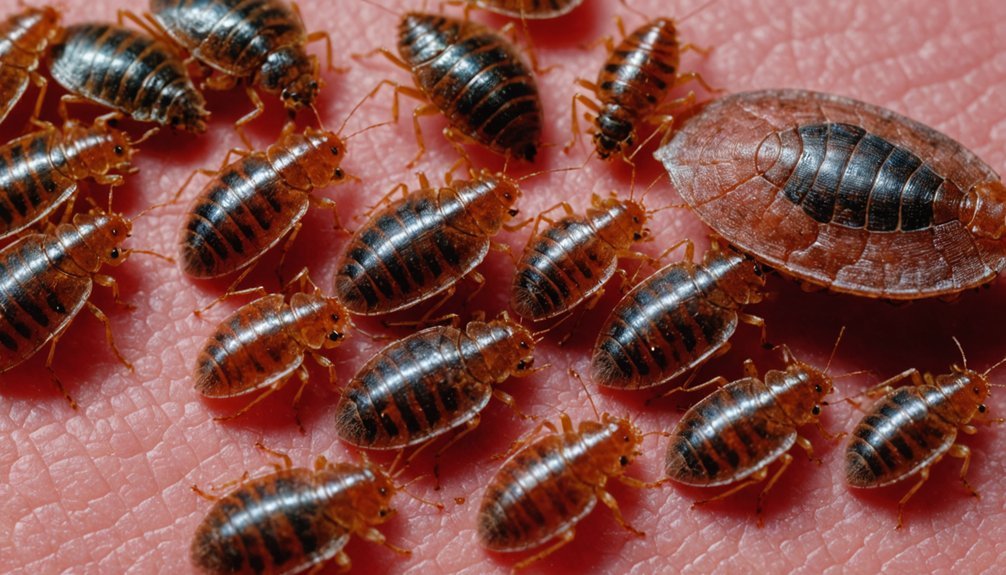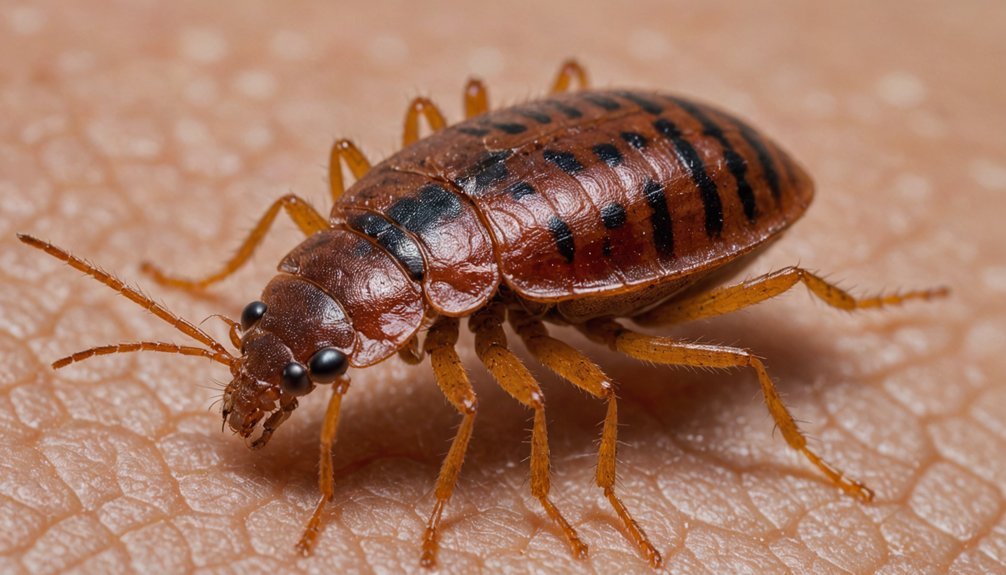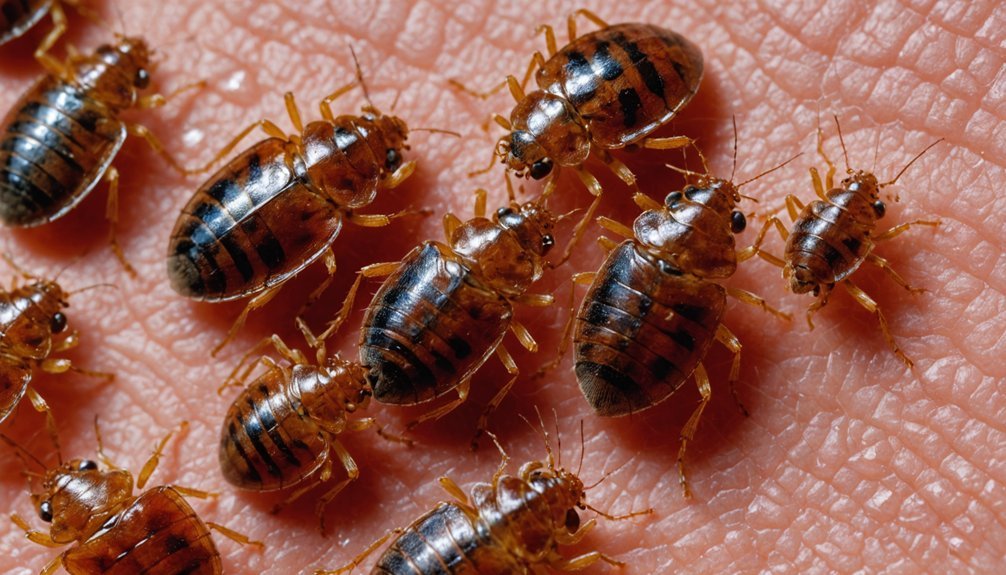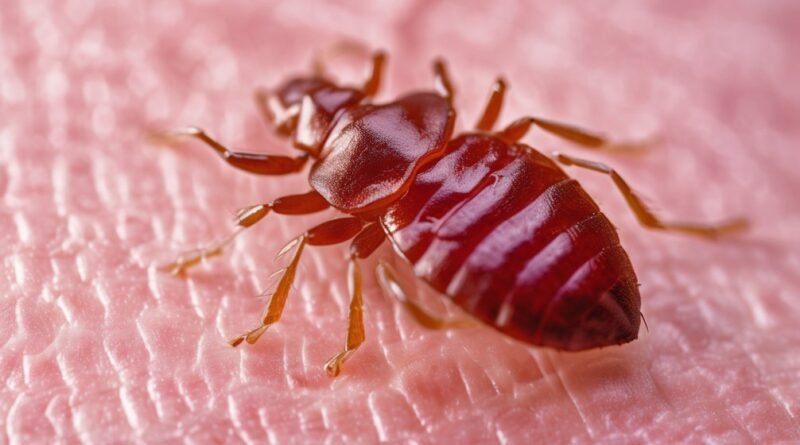Bed Bug Bite Pictures on Arms, Legs & Back
If you’ve noticed mysterious red welts appearing on your arms, legs, or back, you’re likely dealing with bed bug bites. These pesky insects leave behind distinctive calling cards – clusters of itchy bumps that can form straight lines or zigzag patterns across your skin. While identifying these bites isn’t always straightforward, understanding their telltale characteristics will help you confirm whether bed bugs have made themselves at home in your space.
Key Takeaways
- Bed bug bites appear as red, swollen welts forming distinctive linear patterns or clusters, particularly visible on exposed areas of arms, legs, and back.
- Bite marks often follow a “breakfast-lunch-dinner” pattern, creating straight lines or zigzag formations of three or more bites.
- Bites commonly cluster around joints like elbows and knees, with concentrated groupings that can become more inflamed with scratching.
- Red welts may take up to 14 days to appear and typically measure 2-5mm across, often surrounded by a darker red ring.
- Bite locations on arms, legs, and back frequently align with areas exposed during sleep, accompanied by dark fecal spots on nearby bedding.
What Bed Bug Bites Look Like on Different Body Parts

Bed bug bites create distinctive patterns across different areas of your body, though their appearance can vary considerably from person to person. These patterns often manifest as small, red, itchy welts that may appear in a linear or clustered formation. Understanding what bed bugs look like can help you identify an infestation early, as these pests may leave behind physical signs in bedding or furniture. Prompt detection is crucial to preventing a more extensive outbreak in your home.
On your arms, you’ll notice red, raised bumps that often form lines or clusters, especially in areas exposed during sleep. Your legs, particularly ankles and calves, may show similar itchy welts, which can be mistaken for flea bites.
Bed bug bites commonly appear as red, swollen bumps in linear patterns on arms and legs, resembling a trail of inflamed welts.
When examining your back and torso, you’ll find raised marks that might resemble hives or pimple-like eruptions, frequently accompanied by dark fecal spots on bedding. The bedding may also reveal tiny black dots from bedbug excrement.
While upper body bites typically display more prominent swelling, reactions can differ based on skin sensitivity. You’ll notice these bites are concentrated on exposed skin and commonly feature burning sensations, redness, and occasional blistering.
Some people won’t react to the bites at all, making identification more challenging.
Common Patterns and Bite Clusters to Watch For

If you’re checking for bed bug bites, you’ll often spot them in distinctive “breakfast-lunch-dinner” rows of three aligned bites or zigzag patterns across your skin.
You’re likely to find multiple bites clustered around joint areas like elbows, knees, and ankles where your skin is most exposed during sleep. These bites typically develop into small red welts that become increasingly itchy and inflamed over time.
These concentrated groupings, which can appear as tight clusters or linear trails, are telltale signs that separate bed bug bites from random insect bites.
Linear Breakfast-Lunch-Dinner Rows
When searching for signs of bed bug activity, you’ll often notice their distinctive “breakfast, lunch, dinner” bite pattern – a series of three or more bites arranged in a straight or zigzag line.
These linear patterns typically appear on exposed skin areas during sleep, particularly your arms, legs, and back.
Unlike mosquito or flea bites that appear randomly, bed bugs create these sequential bites during a single feeding session as they test multiple spots before settling to feed.
You’ll commonly find these rows on your forearms, wrists, shins, and shoulders. Since bed bugs are nocturnal feeders, their bites are most commonly discovered in the morning.
The bites usually start as small red marks that can develop into itchy welts or blisters within hours or days.
When combined with other signs like blood spots on bedding, these linear patterns strongly indicate a bed bug infestation.
Multiple Bites Near Joints
Beyond the linear patterns of bed bug bites, you’ll notice another common sign of infestation near your body’s joints.
These bites typically cluster around your elbows, knees, wrists, and ankles, where your skin is thinner and more accessible to the insects.
You’ll spot these clusters as red, raised welts with dark centers, often appearing more randomly grouped than the straight-line patterns.
When bed bugs feed, they’ll probe multiple spots near your joints to find the ideal feeding location, creating tight clusters of bites rather than orderly rows.
The bites might be more swollen and irritated in these areas due to skin sensitivity and movement.
Unlike flea bites that concentrate on feet and ankles, these joint-area clusters can appear anywhere your skin folds or joints are exposed during sleep.
The presence of blood stains on sheets from scratching these clustered bites is another telltale sign of bed bug activity.
Clustered Zigzag Bite Groups
Looking closely at bed bug bites, you’ll notice distinctive zigzag patterns and clusters that set them apart from other insect bites. These small, red welts often appear in groups of three or more, following what experts call the “breakfast, lunch, dinner” pattern.
You’ll typically find these clusters on exposed areas of your skin while sleeping, especially on your arms, legs, neck, and back. While the bites themselves are usually not painful, they can become very itchy and swollen.
- Bites appear as tight lines or zigzags, showing the bug’s feeding path along your skin
- Multiple bites cluster together, usually forming groups of 3-5 welts
- Reactions vary from person to person – some may see flat marks while others develop swollen blisters
- Clusters commonly appear on forearms, lower legs, and upper back areas
- The same pattern tends to repeat in similar spots based on your sleeping position
Understanding Bite Reactions and Symptoms

Although bed bug bites affect people differently, understanding the typical reactions and symptoms can help you identify an infestation early.
Early detection of bed bug infestations starts with recognizing how these bites uniquely affect each person’s skin.
You’ll notice small, red welts that often appear in clusters or zigzag patterns, typically on exposed areas of your body like arms, legs, and back. These bites may develop immediately or take up to 14 days to show, and they’re usually accompanied by intense itching and burning sensations.
If you’re among the 30-60% of people who don’t react visibly to bites, you mightn’t notice them at all. However, if you’re sensitive, you could experience severe swelling, blistering, or raised skin patches.
Watch for bite clusters of 3-5 marks, often with a darker center spot resembling tiny hives. Don’t scratch the bites, as this can lead to infections.
Identifying Active Infestations Through Bite Evidence
You’ll find bed bug bites appearing in distinctive clusters or straight lines on exposed skin, especially on your arms, legs, and back where contact occurs during sleep.
Recent feeding activity shows up as small blood spots or crusted lesions near the bite areas, confirming active bed bugs rather than old bites.
The linear or grouped pattern of red, itchy welts often follows the edge of tight clothing or bedding where bugs can easily access your skin while feeding.
Bite Pattern Visual Clues
When investigating potential bed bug infestations, bite pattern evidence serves as a crucial visual indicator of active bug presence.
You’ll typically notice groups of 3-5 bites arranged in lines or zigzag patterns on exposed skin areas while sleeping. These distinctive patterns, often called “breakfast, lunch, and dinner” marks, help distinguish bed bug activity from other insect bites.
- Look for closely spaced bites in straight lines or clusters on arms, shoulders, and back
- Check exposed areas first, as bed bugs rarely bite beneath clothing
- Notice if bites appear differently on various skin tones – red welts on light skin, darker marks on dark skin
- Watch for delayed reactions, as bites may take hours or days to become visible
- Track new bite patterns over time to assess if the infestation is spreading
Evidence of Recent Feeding
Identifying active bed bug infestations requires understanding clear signs of recent feeding activity. You’ll notice small blood drops on sheets and mattresses when bugs can’t fully digest their meals. Fresh bites often appear as itchy welts in clusters or lines on your arms, legs, back, and torso upon waking.
| Evidence Type | Recent Feeding Indicators |
|---|---|
| Blood Signs | Rusty spots on bedding, bright red bugs |
| Skin Reactions | Clustered welts, linear bite patterns |
| Environmental | Black fecal dots, shed skins near harborages |
| Behavioral | Night feeding, morning bite discovery |
Check mattress seams, box springs, and nearby furniture for live bugs, which appear more visible after feeding due to their blood-filled, reddish appearance. A sweet, musty odor and pale yellow eggs with eyespots also signal active infestations.
Clustering and Linear Arrangements
Bed bug bites frequently appear in distinctive clusters and linear patterns, making them easier to distinguish from other insect bites.
You’ll often notice these bites arranged in groups of three or more, commonly called the “breakfast, lunch, and dinner” pattern.
When examining your skin, look for small, red, itchy bumps that follow straight lines or zigzag formations, especially on exposed areas of your body while sleeping.
- Check your arms and legs first, as they’re the most common locations for clustered bites
- Look for dark spots in the center of the bites, which indicate the actual feeding site
- Notice if the bites follow a linear path, particularly along your limbs
- Pay attention to bite clusters on your back, especially near your shoulders
- Remember that bite patterns can vary based on your individual immune response
Natural and Medical Treatment Options
Although bed bug bites typically resolve on their own within 1-2 weeks, various treatment options can help alleviate discomfort and speed up healing.
While bed bug bites heal naturally within a couple weeks, several treatments can reduce symptoms and accelerate recovery time.
For natural relief, you can wash bites with soap and water, apply cold compresses, or create a baking soda paste. Over-the-counter treatments like 1% hydrocortisone cream, calamine lotion, and antihistamine creams effectively reduce itching and inflammation.
If you’re experiencing severe reactions, oral antihistamines like cetirizine or diphenhydramine can provide longer-lasting relief. For complicated cases, your doctor might prescribe stronger medications, including oral corticosteroids or antibiotics if infection develops.
When treating children, be extra cautious – use gentle cleansing methods, keep nails trimmed, and consult healthcare professionals before administering any medications.
Prevention Strategies and Protective Measures
Preventing bed bug infestations requires a multi-layered approach that combines vigilant inspection, smart travel habits, and protective home measures.
You’ll need to be proactive in protecting your home and belongings from these persistent pests, especially when traveling or bringing in second-hand items.
- Inspect your luggage and clothing immediately after travel, focusing on seams, folds, and dark spots that could indicate bed bug presence.
- Store your travel items in sealed plastic bags until you can wash them in hot water and dry on high heat.
- Use certified bed bug encasements on your mattresses and box springs to prevent infestations.
- Place ClimbUp™ interceptors under bed legs to monitor and catch bed bugs before they reach your sleeping area.
- Reduce clutter and regularly vacuum your living spaces, paying special attention to furniture cracks and baseboards.
Conclusion
You’ll know you’re dealing with bed bug bites when you spot red, raised welts in linear patterns or clusters on your arms, legs, and back. Don’t ignore these telltale signs – look for accompanying evidence like blood spots on sheets and dark fecal matter. Take action quickly by treating your bites and contacting a pest professional to eliminate the infestation before it spreads further.

